Resilience Measurements and Dynamics of Resource-Based Cities in Heilongjiang Province, China
Abstract
1. Introduction
2. Study Area and Data
3. Method
3.1. Constructing an Indicator System of Resilience
3.2. Quantifying Indicators Based on PCA
- Unrelated;
- Among all linear combinations of P1, P2, …, Pj, P1 has the largest variance, P2 has the largest variance in the linear combination that is not related to P1, Pj has the largest variance in the linear combination that is not related to P1, P2, …, Pj−1.
3.3. Identifying the Dynamics of Resilience
4. Results and Discussion
4.1. Analysis of the Resilience Values of Nine RBCs
4.2. Spatial Distribution of the Resilience Values of Nine RBCs
4.3. Identification and Analysis of the Resilience Dynamics of Nine RBCs
4.3.1. Overall Resilience Dynamics of 9 RBCs
4.3.2. Resilience Dynamics of RBCs by Type
- Petroleum-based cities
- 2.
- Forest-based cities
- 3.
- Coal-based cities
5. Conclusions and Policy Implications
5.1. Conclusions
- We constructed a resilience indicator system for RBCs in Heilongjiang Province, and applied PCA to specify the indicator weights, brought in standardized data to obtain the resilience values of RBCs in Heilongjiang Province during 2010–2019, and used cluster analysis to classify five grades of resilience. The results show that:
- From 2010 to 2019, the overall resilience values of the nine RBCs exhibited an upward trend;
- There are substantial differences in the level of resilience values between cities, and these differences are primarily attributable to the resource types of cities. The petroleum-based city (Daqing) had the highest level of resilience, followed by the four forest-based cities (Mudanjiang, Hehe, Yichun, and DaHingganLing), and the coal-based cities (Jixi, Shuangyashan, Hegang, and Qitaihe) had the lowest;
- There are group-based characteristics in the spatial distribution of resilience values, with cities within a group tending to develop homogeneously and edge cities being more resilient than inner cities.
- We identified and analyzed the resilience dynamics of RBCs in Heilongjiang Province during 2010–2019 based on the adaptive cycle framework. The results show that:
- Overall, the nine RBCs have the resilience capacity to resist, adapt, and recover from shocks, can recover rapidly, and advance to a higher level of the adaptive cycle following each catastrophic event. They experienced two adaptive cycles during the ten years and entered two Ω release phases in 2013 and 2017, the primary causes of which may have been the financial crisis and policy changes;
- From the perspective of the resilience dynamics of different types of RBCs, the resilience dynamics of petroleum-based cities exhibit a stepped growth trend, with high resilience capacity, being less affected by shocks, and recovering quickly. The resilience dynamics of forest-based cities exhibit a smooth fluctuating trend, with the capacity to recover after being affected by shocks, but in a stable stage for a long time, and the resilience has not been raised to a higher level. The resilience dynamics of coal-based cities exhibit a fluctuating trend, and prior to 2017, the resilience capacity was low, affected by shocks, and it was difficult to raise resilience to a higher level after recovery; after that, resilience increased rapidly to a higher level.
5.2. Policy Implications
5.3. Research Limitations and Prospects
Author Contributions
Funding
Data Availability Statement
Acknowledgments
Conflicts of Interest
References
- Yang, Y.; Fang, Y.; Xu, Y.; Zhang, Y. Assessment of urban resilience based on the transformation of resource-based cities: A case study of Panzhihua, China. Ecol. Soc. 2021, 26, 20. [Google Scholar] [CrossRef]
- Liu, Z.; Zhou, W.; Yao, H. Progress of studies abroad on development and transition of resource-based cities. China Popul. Resour. Environ. 2011, 21, 161–168. [Google Scholar]
- Hu, Y.; Liu, Y.; Sun, H. Process and factors of urban growth and shrinkage: A case study of mining cities in Heilongjiang Province. Sci. Geogr. Sin. 2020, 40, 1450–1459. [Google Scholar] [CrossRef]
- Wang, W.; Lu, C.; Wang, Y. Problems countermeasures of population loss in resource-based cities in Heilongjiang. China Population. Resour. Environ. 2018, 28, 63–66. [Google Scholar]
- Li, Z.; Hou, S.; Huang, Y.; Xu, H. Land Ecological Security Evaluation of Coal-Resource Cities in Heilongjiang Province:A Case Study of Shuangyashan City. Sci. Technol. Manag. Land Resour. 2011, 28, 46–51. [Google Scholar]
- Turner, B.L., II. Vulnerability and resilience: Coalescing or paralleling approaches for sustainability science? Glob. Environ. Chang. 2010, 20, 570–576. [Google Scholar] [CrossRef]
- Batty, M. The size, scale, and shape of cities. Science 2008, 319, 769–771. [Google Scholar] [CrossRef]
- Cumming, G.S.; Barnes, G.; Perz, S.; Schmink, M.; Sieving, K.E.; Southworth, J.; Binford, M.; Holt, R.D.; Stickler, C.; Van Holt, T. An exploratory framework for the empirical measurement of resilience. Ecosystems 2005, 8, 975–987. [Google Scholar] [CrossRef]
- Carpenter, S.; Walker, B.; Anderies, J.M.; Abel, N. From metaphor to measurement: Resilience of what to what? Ecosystems 2001, 4, 765–781. [Google Scholar] [CrossRef]
- Walker, B.; Holling, C.S.; Carpenter, S.R.; Kinzig, A. Resilience, Adaptability and Transformability in Social-Ecological Systems. Ecol. Soc. 2004, 9, 5. Available online: http://www.jstor.org/stable/26267673 (accessed on 21 January 2022). [CrossRef]
- Folke, C. Resilience: The emergence of a perspective for social–ecological systems analyses. Glob. Environ. Chang. 2006, 16, 253–267. [Google Scholar] [CrossRef]
- Folke, C.; Carpenter, S.R.; Walker, B.; Scheffer, M.; Chapin, T.; Rockström, J. Resilience Thinking: Integrating Resilience, Adaptability and Transformability. Ecol. Soc. 2010, 15, 20. Available online: https://www.jstor.org/stable/26268226 (accessed on 21 January 2022). [CrossRef]
- Carpenter, S.R.; Arrow, K.J.; Barrett, S.; Biggs, R.; Brock, W.A.; Crépin, A.-S.; Engström, G.; Folke, C.; Hughes, T.P.; Kautsky, N.; et al. General Resilience to Cope with Extreme Events. Sustainability 2012, 4, 3248–3259. [Google Scholar] [CrossRef]
- Berkes, F. Environmental Governance for the Anthropocene? Social-Ecological Systems, Resilience, and Collaborative Learning. Sustainability 2017, 9, 1232. [Google Scholar] [CrossRef]
- Meerow, S.; Newell, J.P.; Stults, M. Defining urban resilience: A review. Landsc. Urban Plan. 2015, 147, 38–49. [Google Scholar] [CrossRef]
- Godschalk, D.R. Urban hazard mitigation: Creating resilient cities. Nat. Hazards Rev. 2003, 4, 136–143. [Google Scholar] [CrossRef]
- Holling, C.S. Resilience and stability of ecological systems. Annu. Rev. Ecol. Syst. 1973, 4, 1–23. Available online: https://www.jstor.org/stable/2096802 (accessed on 21 January 2022). [CrossRef]
- Allen, C.R.; Holling, C.S. Novelty, adaptive capacity, and resilience. Ecol. Soc. 2010, 15, 24. Available online: https://www.jstor.org/stable/26268188 (accessed on 21 January 2022). [CrossRef]
- Holling, C.S.; Gunderson, L.; Peterson, G. Sustainability and Panarchies. In Panarchy: Understanding Transformations in Human and Natural Systems; Gunderson, L.H., Holling, C.S., Eds.; Island Press: Washington, DC, USA, 2002; pp. 63–102. [Google Scholar]
- The Resilience Alliance. Available online: https://www.resalliance.org/key-concepts (accessed on 21 January 2022).
- Li, K.X.; Hu, H.; Zhao, H.M. Evolution analysis of regional social-ecological systems based on adaptive cycle theory and Pressure-State-Response framework. Acta Ecol. Sin. 2022, 42, 1–16. [Google Scholar] [CrossRef]
- Li, Y.; Kappas, M.; Li, Y.F. Exploring the coastal urban resilience and transformation of coupled human-environment systems. J. Clean. Prod. 2018, 195, 1505–1511. [Google Scholar] [CrossRef]
- Luo, F.; Liu, Y.; Peng, J.; Wu, J. Assessing urban landscape ecological risk through an adaptive cycle framework. Landsc. Urban Plan. 2018, 180, 125–134. [Google Scholar] [CrossRef]
- Zhang, L.; Huang, Q.; He, C.; Yue, H.; Zhao, Q. Assessing the dynamics of sustainability for social-ecological systems based on the adaptive cycle framework: A case study in the Beijing-Tianjin-Hebei urban agglomeration. Sustain. Cities Soc. 2021, 70, 102899. [Google Scholar] [CrossRef]
- Ding, X.C.; Zhang, Y. Research on transition and development mode of resource-based cities according to the cycle theory. World Reg. Stud. 2008, 3, 70–76. [Google Scholar]
- Mao, J.X.; He, Y.J. Study on the lifecycle model of resource-intensive cities. Geogr. Geo-Inf. Sci. 2008, 24, 56–60. [Google Scholar]
- Holling, C.S. Understanding the complexity of economic, ecological and social systems. Ecosystems 2001, 4, 390–405. [Google Scholar] [CrossRef]
- Shao, Y.; Xu, J. Understanding Urban Resilience: A Conceptual Analysis Based on Integrated International Literature Review. Urban Plan. Int. 2015, 30, 48–54. [Google Scholar]
- The State Council the People’s Republic of China. Available online: http://www.gov.cn/zwgk/2013-12/03/content_2540070.htm (accessed on 21 January 2022).
- Zhang, W.Z.; Wang, D.; Yu, J.H. Study on the Development Path and Pattern of Substituted Industry in Resource-Based Cities. Bull. Chin. Acad. Sci. 2011, 26, 134–141. [Google Scholar]
- Dong, S.; Li, Z.H.; Li, B.; Xue, M. The problems and strategies on economic transformation of resource-based cities in China. China Popul. Resour. Environ. 2007, 5, 12–17. [Google Scholar]
- National Bureau of Statistics of China. Available online: http://www.stats.gov.cn/english/ (accessed on 21 January 2022).
- Yang, J.; Huang, X. The 30 m annual land cover dataset and its dynamics in China from 1990 to 2019. Earth Syst. Sci. Data 2021, 13, 3907–3925. [Google Scholar] [CrossRef]
- Brelsford, C.; Lobo, J.; Hand, J.; Bettencourt, L.M. Heterogeneity and scale of sustainable development in cities. PNAS 2017, 114, 8963–8968. [Google Scholar] [CrossRef]
- Allington, G.R.; Li, W.; Brown, D.G. Urbanization and environmental policy effects on the future availability of grazing resources on the Mongolian Plateau: Modeling socio-environmental system dynamics. Environ. Sci. Policy 2017, 68, 35–46. [Google Scholar] [CrossRef]
- Pelling, M.; Manuel-Navarrete, D. From resilience to transformation: The adaptive cycle in two Mexican urban centers. Ecol. Soc. 2011, 16, 11. [Google Scholar] [CrossRef]
- Jabareen, Y. Planning the resilient city: Concepts and strategies for coping with climate change and environmental risk. Cities 2013, 31, 220–229. [Google Scholar] [CrossRef]
- Hosseini, S.; Barker, K.; Ramirez-Marquez, J.E. A review of definitions and measures of system resilience. Reliab. Eng. Syst. Saf. 2016, 145, 47–61. [Google Scholar] [CrossRef]
- Dicken, P. Global Shift: Mapping the Changing Contours of the World Economy, 6th ed.; Guilford Press: New York, NY, USA, 2011; p. 20. [Google Scholar]
- Assessing Resilience in Social-Ecological Systems: Workbook for Practitioners. Available online: http://www.resalliance.org/3871.php (accessed on 21 January 2022).
- Christopher, B.G. A Validation of Metrics for Community Resilience to Natural Hazards and Disasters Using the Recovery from Hurricane Katrina as a Case Study. Ann. Assoc. Am. Geogr. 2015, 105, 67–86. [Google Scholar] [CrossRef]
- The Rockefeller Foundation and ARUP. City Resilience Framework. Available online: https://www.urban-response.org/system/files/content/resource/files/main/city-resilience-framework-arup-april-2014.pdf (accessed on 21 January 2022).
- Cutter, S.L.; Ash, K.D.; Emrich, C.T. The geographies of community disaster resilience. Glob. Environ. Chang. 2014, 29, 65–77. [Google Scholar] [CrossRef]
- Orencio, P.M.; Fujii, M. A localized disaster-resilience index to assess coastal communities based on an analytic hierarchy process (AHP). Int. J. Disaster Risk Reduct. 2013, 3, 62–75. [Google Scholar] [CrossRef]
- Constructing a Resilience Index for the Enhanced Critical Infrastructure Protection Program. Available online: https://www.osti.gov/servlets/purl/991101 (accessed on 21 January 2022).
- Hosseini, H.; Kaneko, S. Dynamic sustainability assessment of countries at the macro level: A principal component analysis. Ecol. Indic. 2011, 11, 811–823. [Google Scholar] [CrossRef]
- Douka, H.; Papadopoulos, A.; Savakis, N.; Tsoutsos, T.; Psarras, J. Assessing energy sustainability of rural communities using principal component analysis. Renew. Sustain. Energy Rev. 2012, 16, 1949–1957. [Google Scholar] [CrossRef]
- Tan, F.; Lu, Z. Study on the interaction and relation of society economy and environment based on PCA–VAR model: As a case study of the Bohai Rim region, China. Ecol. Indic. 2015, 48, 31–40. [Google Scholar] [CrossRef]
- Abou-Ali, H.; Abdelfattah, Y. Integrated paradigm for sustainable development: A panel data study. Econ. Model. 2013, 30, 334–342. [Google Scholar] [CrossRef]
- Wang, D.; Yang, H.; Hu, Y.; Zhu, A.X.; Mao, X. Analyzing Spatio-Temporal Characteristics of Cultivated Land Fragmentation and Their Influencing Factors in a Rapidly Developing Region: A Case Study in Guangdong Province, China. Land 2022, 11, 1750. [Google Scholar] [CrossRef]
- Walker, B.; Salt, D. Resilience Thinking: Sustaining Ecosystems and People in a Changing World; Island Press: Washington, DC, USA, 2015; pp. 25–27. [Google Scholar]
- Walker, B.; Salt, D. Resilience Practice: Buiding Capacity; Island Press: Washington, DC, USA, 2012; pp. 33–34. [Google Scholar]
- Fath, B.D.; Dean, C.A.; Harald, K. Navigating the adaptive cycle: An approach to managing the resilience of social systems. Ecol. Soc. 2015, 20, 24. [Google Scholar] [CrossRef]
- Beier, C.M.; Lovecraft, A.L.; Chapin, F.S., III. Growth and collapse of a resource system: An adaptive cycle of change in public lands governance and forest management in Alaska. Ecol. Soc. 2009, 14, 5. Available online: http://www.ecologyandsociety.org/vol14/iss2/art5/ (accessed on 21 January 2022). [CrossRef]
- Li, X.; Zhuang, X. Eco-City Problems: Industry–City–Ecology, Urbanization Development Assessment in Resource-Exhausted Cities. Sustainability 2023, 15, 166. [Google Scholar] [CrossRef]
- Ming, L.; Chang, J.; Li, C.; Chen, Y.; Li, C. Spatial-Temporal Patterns of Ecosystem Services Supply-Demand and Influencing Factors: A Case Study of Resource-Based Cities in the Yellow River Basin, China. Int. J. Environ. Res. Public Health 2022, 19, 16100. [Google Scholar] [CrossRef]
- Long, R.; Li, H.; Wu, M. Dynamic evaluation of the green development level of China’s coal-resource-based cities using the TOPSIS method. Resour. Policy 2021, 74, 102415. [Google Scholar] [CrossRef]
- di Santo, N.; Russo, I.; Sisto, R. Climate Change and Natural Resource Scarcity: A Literature Review on Dry Farming. Land 2022, 11, 2102. [Google Scholar] [CrossRef]
- Liao, L.; Du, M.; Huang, J. The Effect of Urban Resilience on Residents’ Subjective Happiness: Evidence from China. Land 2022, 11, 1896. [Google Scholar] [CrossRef]
- Zheng, Y.; Cheng, L.; Wang, Y. Measuring the Spatial Conflict of Resource-Based Cities and Its Coupling Coordination Relationship with Land Use. Land 2022, 11, 1460. [Google Scholar] [CrossRef]
- Zhang, S.; Wang, L.; Wu, X. Population Shrinkage, Public Service Levels, and Heterogeneity in Resource-Based Cities: Case Study of 112 Cities in China. Sustainability 2022, 14, 15910. [Google Scholar] [CrossRef]
- Beatley, T.; Newman, P. Biophilic Cities Are Sustainable, Resilient Cities. Sustainability 2013, 5, 3328–3345. [Google Scholar] [CrossRef]
- Shi, C.; Guo, N.; Zhu, X.; Wu, F. Assessing Urban Resilience from the Perspective of Scaling Law: Evidence from Chinese Cities. Land 2022, 11, 1803. [Google Scholar] [CrossRef]
- Huang, J.; Sun, Z.; Du, M. Differences and Drivers of Urban Resilience in Eight Major Urban Agglomerations: Evidence from China. Land 2022, 11, 1470. [Google Scholar] [CrossRef]
- Ministry of Natural Resources of the People’s Republic of China. National Mineral Resources Planning (2016–2020). Available online: https://www.mnr.gov.cn/gk/ghjh/201811/t20181101_2324927.html (accessed on 21 January 2022).
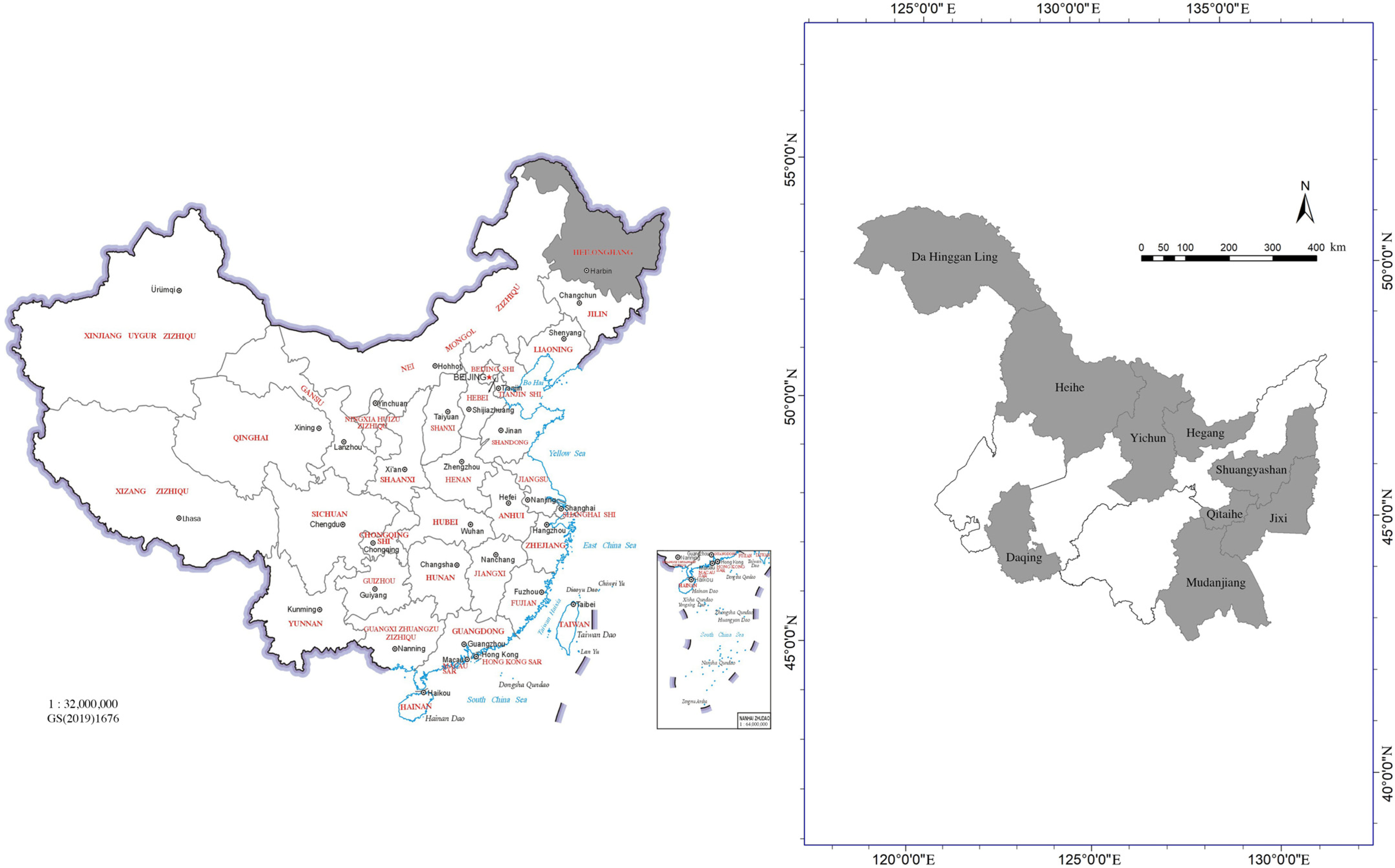
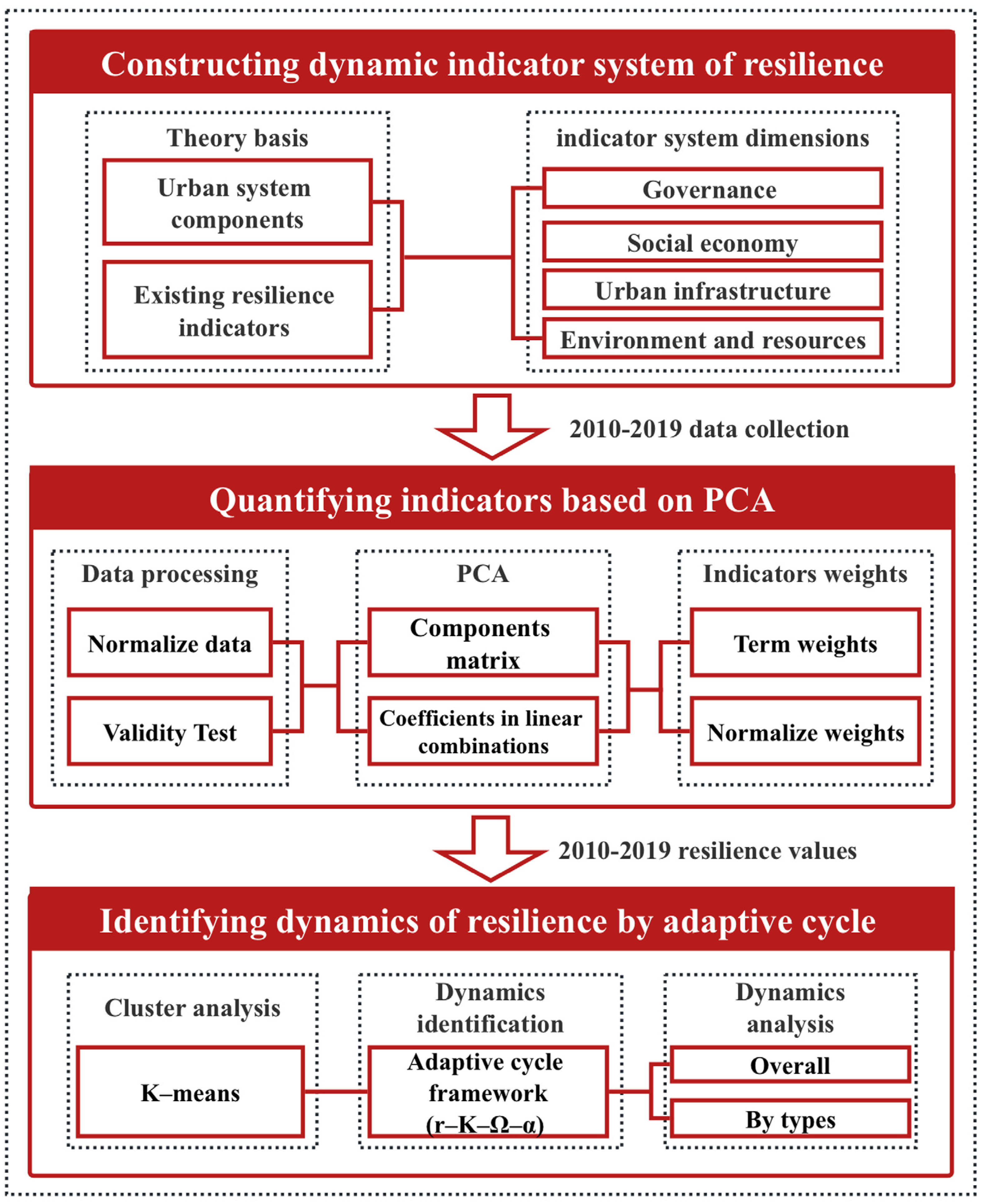
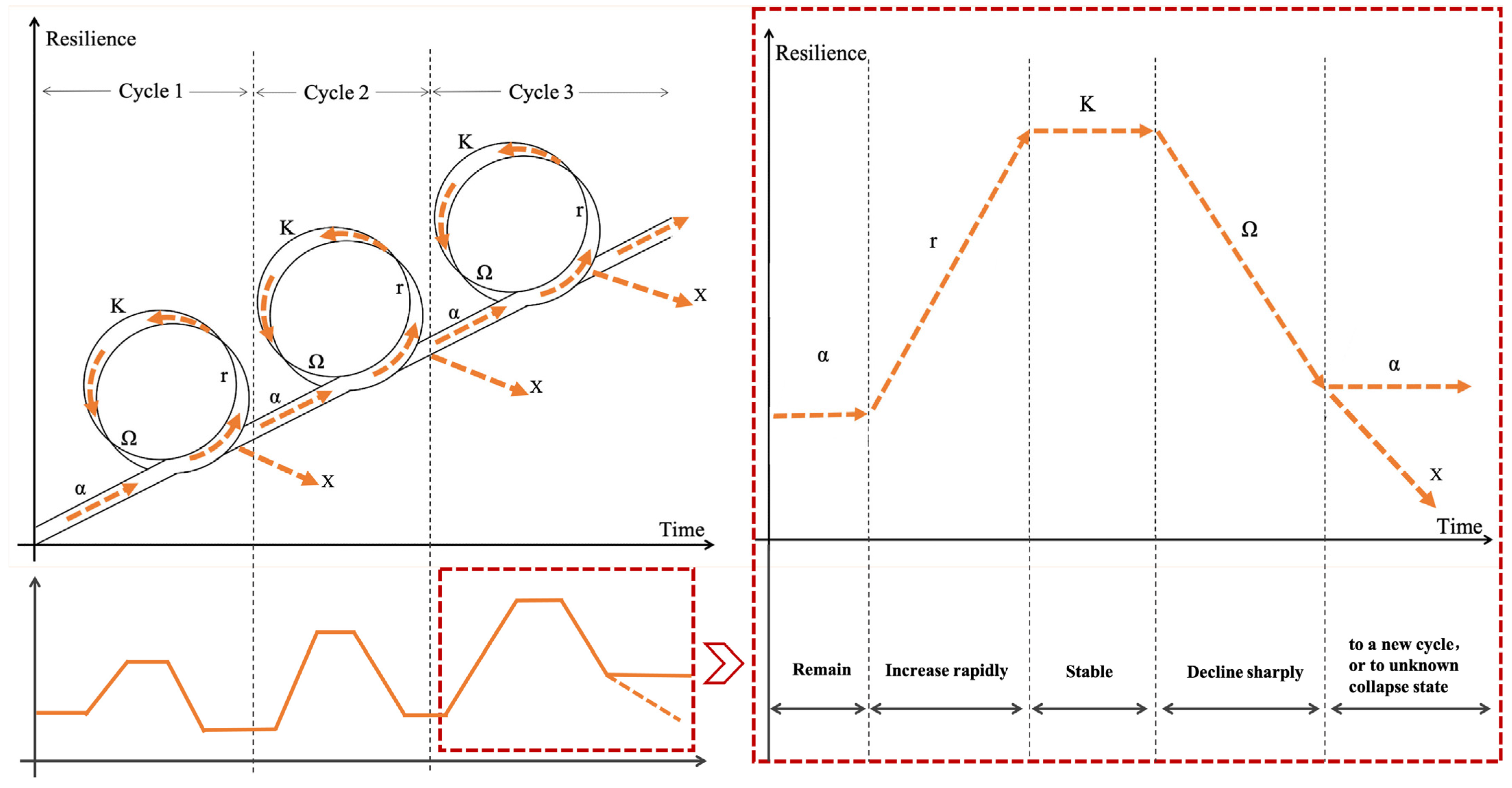

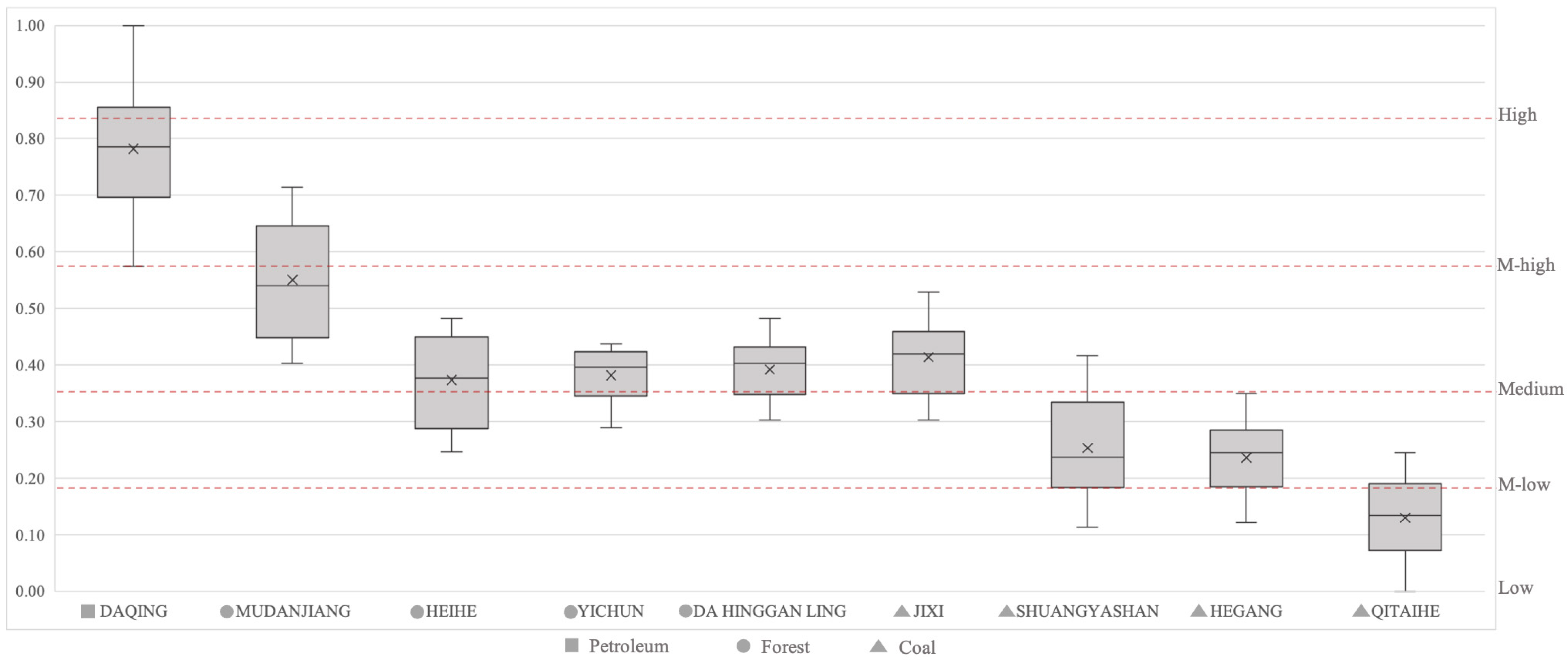
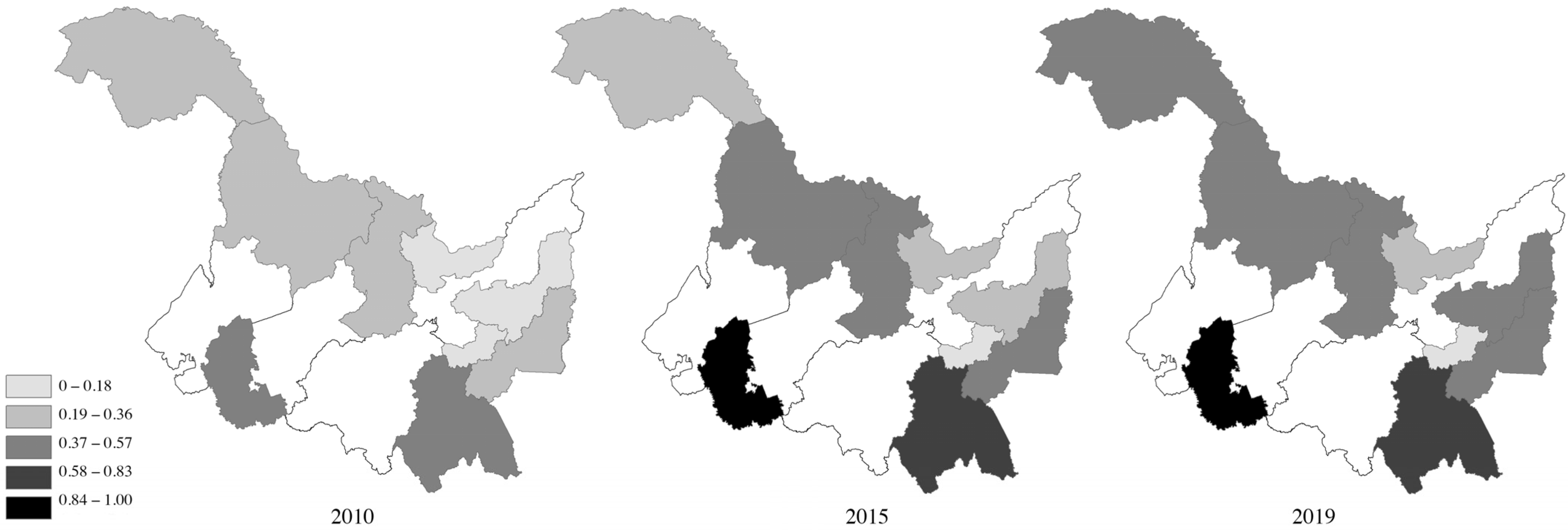



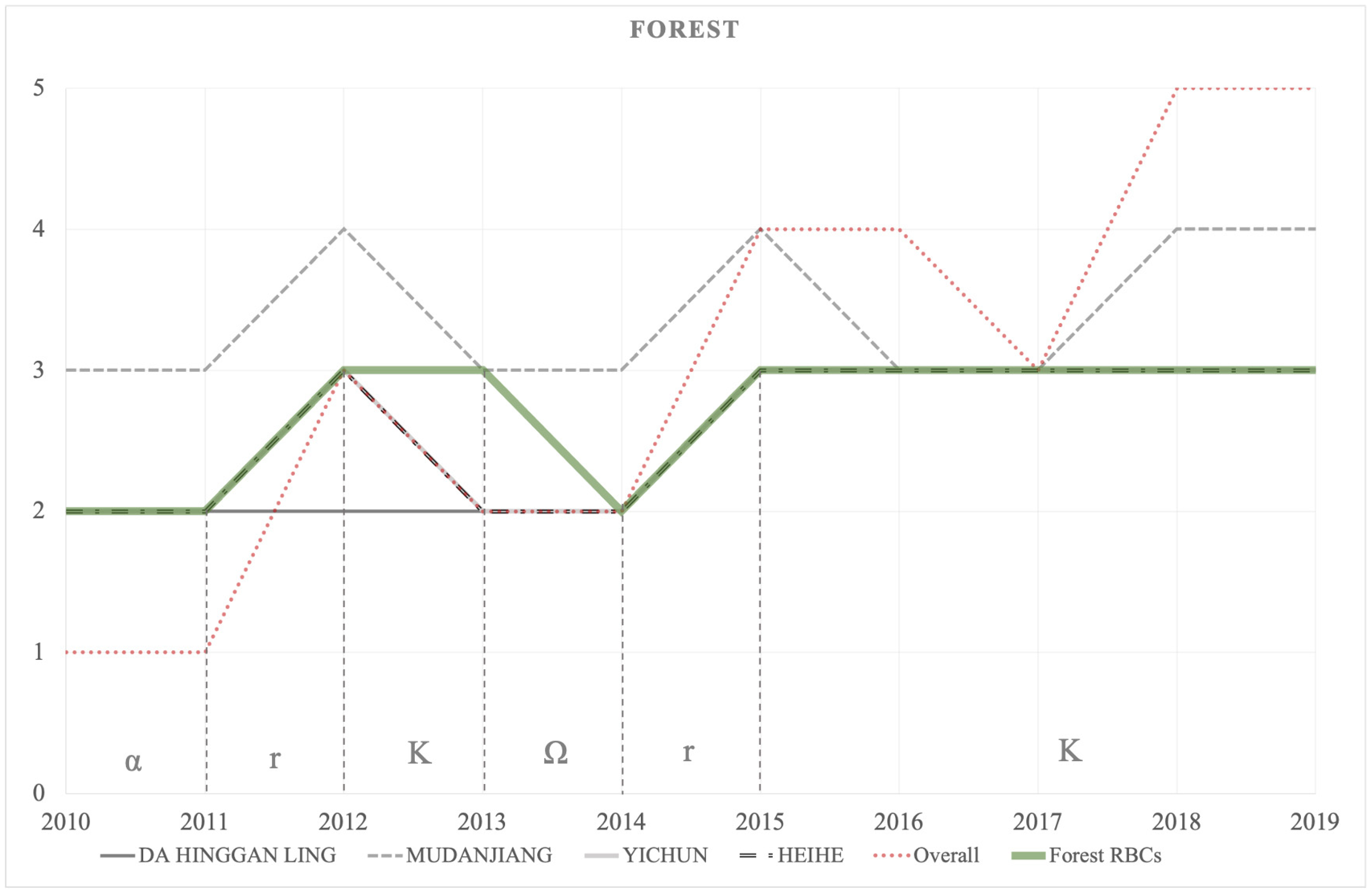

| Resilience Assessment | References | Categories | Indicators |
|---|---|---|---|
| Sustainability evaluation index framework | [24] | Human, | 19 |
| Environmental | |||
| Evaluation system of resource-based cities’ urban resilience | [1] | Health and wellbeing, | 37 |
| Infrastructure and environment, | |||
| Economy and society, | |||
| Government management capacity | |||
| Indicators for urban landscape ecological risk assessment | [23] | Potential, | 12 |
| Connectedness, | |||
| Resilience | |||
| Indicators for resilience in human-environment sub-systems | [22] | Human, | 18 |
| Environment | |||
| Indicators for resilience assessment | [41] | Social, | 98 |
| Economic, | |||
| Institutional Community capital, | |||
| Infrastructure, | |||
| Environmental systems | |||
| City resilience framework | [42] | Health and wellbeing, | 52 |
| Infrastructure and environment, | |||
| Economy and society, | |||
| Leadership and strategy | |||
| Baseline resilience indicators for communities | [43] | Social, | 49 |
| Housing/infrastructural, | |||
| Community capital, | |||
| Economic, | |||
| Institutional, | |||
| Environmental | |||
| Index for a disaster-resilient coastal community | [44] | Environmental and natural resource management, | 75 |
| Human health and wellbeing, | |||
| Sustainable livelihoods, | |||
| Physical structural and technical measures, | |||
| Planning regimes, | |||
| Financial instruments, | |||
| Social protection | |||
| Resilience index for enhanced Critical infrastructure protection | [45] | Robustness, | 47 |
| Resourcefulness, | |||
| Recovery |
| Dimensions | Groups | Indicators | Attributes | Data Sources |
|---|---|---|---|---|
| Governance | Government services | Annual volume of cases | + | Public data |
| Immediate action rate | + | Public data | ||
| State-owned enterprises | Proportion of employment in state-owned companies | + | Statistics | |
| Government guarantee | Number of public management and social security units | + | Statistics | |
| NGOs | Number of social groups and religious organizations | + | Statistics | |
| Industrial structure | Primary industry share | - | Statistics | |
| Secondary industry share | - | Statistics | ||
| Tertiary industry share | + | Statistics | ||
| Resource-based industries | Proportion of employment in forestry and mining | - | Statistics | |
| Social economy | Human Resources | High school education or above | + | Statistics |
| Year-end employment | + | Statistics | ||
| R&D personnel | + | Statistics | ||
| Demographic composition | Natural population growth rate | + | Statistics | |
| Proportion of population aged 15–64 | + | Statistics | ||
| Proportion of population over 65 years old | - | Statistics | ||
| Social welfare | Number of participants in basic endowment insurance | + | Statistics | |
| Minimum subsistence allowance for urban residents | - | Statistics | ||
| Per capita unemployment rate | - | Statistics | ||
| Number of community service facilities | + | Statistics | ||
| Resident health | Number of participants in urban basic medical insurance | + | Statistics | |
| Number of beds in health institutions | + | Statistics | ||
| Number of practicing physicians | + | Statistics | ||
| Economic capital | Balance of financial institutions | + | Statistics | |
| Government public finance revenue | + | Statistics | ||
| Household deposit balance | + | Statistics | ||
| Per capita disposable income of residents | + | Statistics | ||
| Economic development | Per capita GDP | + | Statistics | |
| GDP growth rate | + | Statistics | ||
| Economic circulation | Total retail sales of consumer goods | + | Statistics | |
| Total export-import volume | + | Statistics | ||
| Urban infrastructure | Urban construction | Urban land area | + | Remote sensing |
| Proportion of urban construction land | + | Remote sensing | ||
| Municipal service facilities | Length of water supply pipeline | + | Statistics | |
| Length of drainage pipeline | + | Statistics | ||
| Length of natural gas pipeline | + | Statistics | ||
| Number of lighting facilities | + | Statistics | ||
| Number of primary schools | + | Statistics | ||
| Number of secondary schools | + | Statistics | ||
| Number of colleges and universities | + | Statistics | ||
| Number of hospitals | + | Statistics | ||
| Living service facilities | Number of theaters | + | Statistics | |
| Number of sports venues | + | Statistics | ||
| Number of large wholesale and retail services | + | Statistics | ||
| Number of large accommodation and catering services | + | Statistics | ||
| Communication | Total telecommunication services | + | Statistics | |
| Total post services | + | Statistics | ||
| Transportation | Road length | + | Statistics | |
| Per capita public transportation | + | Statistics | ||
| Per capita urban road area | + | Statistics | ||
| Green space | Greening coverage of built-up areas | + | Statistics | |
| Urban green space | + | Statistics | ||
| Environment and resources | Agricultural resources | Cultivated coverage area | + | Remote sensing |
| Grassland coverage area | + | Remote sensing | ||
| Water resources | Water coverage area | + | Remote sensing | |
| Total water resources | + | Public data | ||
| Forest resources | Forest covered area | + | Remote sensing | |
| Ecological resources | Wetland coverage area | + | Remote sensing | |
| Number of nature reserves | + | Statistics | ||
| Climate | Annual precipitation | - | Public data | |
| Energy consumption | Combined energy consumption | - | Statistics | |
| Wastes | Wastewater discharge | - | Statistics | |
| SO2 emissions | - | Statistics |
| Grades | Low Resilience | Medium-Low Resilience | Medium Resilience | Medium-High Resilience | High Resilience |
|---|---|---|---|---|---|
| Overall | 0–0.18 | 0.19–0.36 | 0.37–0.57 | 0.58–0.83 | 0.84–1.00 |
| Dimensions | 0–0.23 | 0.24–0.34 | 0.35–0.53 | 0.54–0.85 | 0.86–1.00 |
| Cluster members | 1 | 2 | 3 | 4 | 5 |
Disclaimer/Publisher’s Note: The statements, opinions and data contained in all publications are solely those of the individual author(s) and contributor(s) and not of MDPI and/or the editor(s). MDPI and/or the editor(s) disclaim responsibility for any injury to people or property resulting from any ideas, methods, instructions or products referred to in the content. |
© 2023 by the authors. Licensee MDPI, Basel, Switzerland. This article is an open access article distributed under the terms and conditions of the Creative Commons Attribution (CC BY) license (https://creativecommons.org/licenses/by/4.0/).
Share and Cite
Lu, M.; Tan, Z.; Yuan, C.; Dong, Y.; Dong, W. Resilience Measurements and Dynamics of Resource-Based Cities in Heilongjiang Province, China. Land 2023, 12, 302. https://doi.org/10.3390/land12020302
Lu M, Tan Z, Yuan C, Dong Y, Dong W. Resilience Measurements and Dynamics of Resource-Based Cities in Heilongjiang Province, China. Land. 2023; 12(2):302. https://doi.org/10.3390/land12020302
Chicago/Turabian StyleLu, Ming, Zhuolin Tan, Chao Yuan, Yu Dong, and Wei Dong. 2023. "Resilience Measurements and Dynamics of Resource-Based Cities in Heilongjiang Province, China" Land 12, no. 2: 302. https://doi.org/10.3390/land12020302
APA StyleLu, M., Tan, Z., Yuan, C., Dong, Y., & Dong, W. (2023). Resilience Measurements and Dynamics of Resource-Based Cities in Heilongjiang Province, China. Land, 12(2), 302. https://doi.org/10.3390/land12020302












